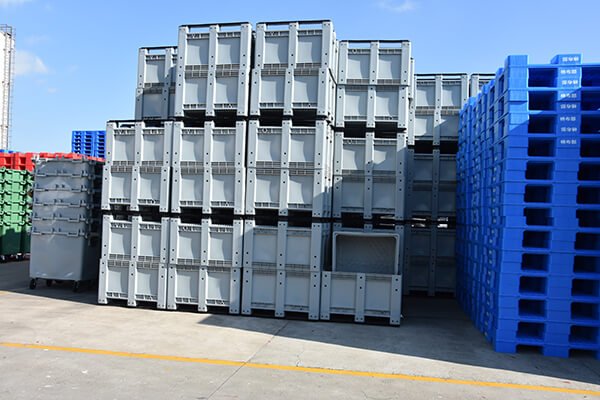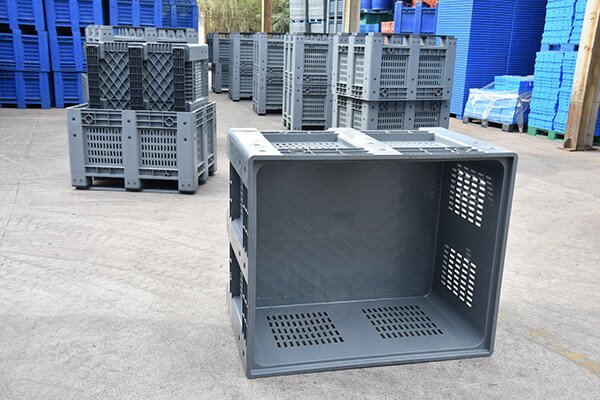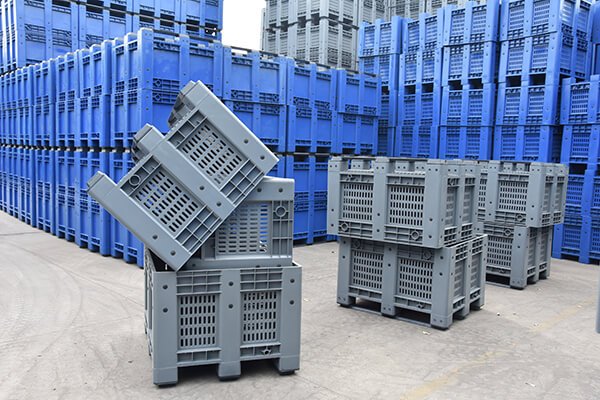Food safety is a top priority across the global supply chain. From farm to fork, ensuring that food products are handled, stored, and transported in a manner that preserves their quality and prevents contamination is essential to consumer health and regulatory compliance. In this highly regulated environment, the ventilated pallet boxes are an often-overlooked hero of food safety.
Ventilated pallet boxes, especially food-grade plastic ones, are indispensable in maintaining hygiene standards and regulatory compliance in storing and transporting perishable items. Their unique design and features help businesses adhere to food safety protocols set by global and regional authorities such as the FDA (Food and Drug Administration), HACCP (Hazard Analysis and Critical Control Points), and BRCGS (Brand Reputation Compliance Global Standards).

This post will dive into how ventilated pallet boxes contribute to food safety compliance and why they are a must-have in food handling operations.
1. Improved Airflow Reduces Contamination Risks
Ventilated pallet boxes feature perforated sides and bases that facilitate optimal airflow around the stored goods. This ventilation helps prevent the buildup of moisture and heat, both of which can accelerate bacterial growth and food spoilage.
Moisture control is critical in food safety. Excessive humidity inside storage containers can lead to mold, mildew, and bacterial contamination, especially in fresh produce, meat, and dairy products. With ventilated boxes, air circulates freely, reducing the chances of condensation forming inside the box. This makes it easier to maintain a clean and safe storage environment that discourages microbial growth.
2. Hygienic Design and Easy Sanitation
Unlike wooden crates or cardboard boxes, ventilated pallet boxes made from high-density polyethylene (HDPE) or polypropylene (PP) are non-porous and resistant to moisture absorption. These materials do not harbor bacteria, fungi, or pests, and they can withstand rigorous cleaning protocols.
Most ventilated pallet boxes are designed with smooth surfaces and rounded corners to eliminate crevices where dirt or bacteria can accumulate. This makes them easy to sanitize using pressure washers, steam cleaning, or chemical disinfectants. Their ability to withstand repeated wash cycles without degrading ensures long-term hygiene and reusability.
This hygienic design supports compliance with food safety standards like HACCP, which emphasizes the importance of eliminating critical contamination points throughout the food supply chain.
3. Compliance with Regulatory Standards
Many ventilated pallet boxes are manufactured to meet stringent regulatory standards. For example:
- FDA Compliance: Boxes made from FDA-approved materials are safe for direct contact with food items.
- HACCP Principles: The easy-clean, non-absorbent, and durable construction supports hazard control points.
- BRCGS Certification: These boxes contribute to site-wide hygiene and operational controls that meet BRC Global Standards.
Using ventilated pallet boxes that are certified or compliant with these standards makes it easier for businesses to pass audits and inspections conducted by regulatory bodies.
4. Prevention of Cross-Contamination
Cross-contamination occurs when bacteria or allergens from one product are transferred to another, potentially causing serious health risks. In food production and distribution environments, shared surfaces and inadequate storage solutions can significantly increase this risk.
Ventilated pallet boxes minimize cross-contamination through their:
- Dedicated use per product or batch
- Color coding systems for easy product segregation
- Easy labeling areas to track content and prevent mix-ups
Moreover, their resistance to moisture and ease of cleaning ensure that no residues or contaminants are left behind after each use.

5. Temperature Control in Cold Chain Logistics
Maintaining the correct temperature is one of the most critical aspects of food safety. Spoiled products not only cause financial losses but also pose health risks. Ventilated pallet boxes play an important role in cold chain logistics by supporting efficient cooling and freezing processes.
The airflow-enabled design allows cold air to circulate uniformly around the products, ensuring even temperature distribution. This is particularly important for products such as fresh produce, seafood, and dairy, which are highly sensitive to temperature fluctuations.
Improved temperature control helps businesses stay within the safe temperature range required by food safety standards, thereby avoiding penalties and product recalls.
6. Traceability and Inventory Management
Food safety compliance is not just about physical conditions but also about traceability. Regulatory frameworks often require the ability to trace products back to their source and track their movement through the supply chain.
Many modern ventilated pallet boxes support traceability efforts with features like:
- Integrated RFID tags or barcodes
- Label holders for quick identification
- Color-coded or serialized designs
These features streamline inventory management, help track contamination sources, and facilitate recall processes when necessary.
7. Durability Reduces Risk of Contamination
Weak or broken storage containers can collapse, leak, or split, potentially exposing food to contaminants. Ventilated pallet boxes are engineered for durability and can withstand rough handling in demanding environments. Their robust structure prevents product damage and maintains hygiene integrity throughout multiple use cycles.
Because they are reusable and resistant to wear, they also reduce the need for frequent replacements, which lowers the chances of introducing new contamination risks with each new batch of containers.

8. Environmental Compliance and Sustainability
Food safety compliance is increasingly being viewed through the lens of sustainability. Consumers and regulators alike are pushing for more sustainable food systems, and packaging plays a big part in this shift.
Ventilated pallet boxes are often made from recyclable materials, and their reusability reduces waste compared to single-use packaging. Many models are manufactured using BPA-free, food-grade plastic, further enhancing their safety credentials. Using sustainable containers can support certifications and standards related to environmental responsibility.
Conclusion
In the complex web of food safety compliance, ventilated pallet boxes offer a surprisingly simple yet effective solution. From enhancing hygiene and airflow to supporting traceability and regulatory compliance, these boxes contribute on multiple fronts to a safer, more efficient supply chain.
For businesses in agriculture, food processing, and distribution, adopting ventilated pallet boxes is not just a logistical decision—it’s a critical step toward protecting consumer health and meeting the highest food safety standards. As regulations continue to evolve and expectations rise, investing in the right storage solutions today can help future-proof your operations for tomorrow.

